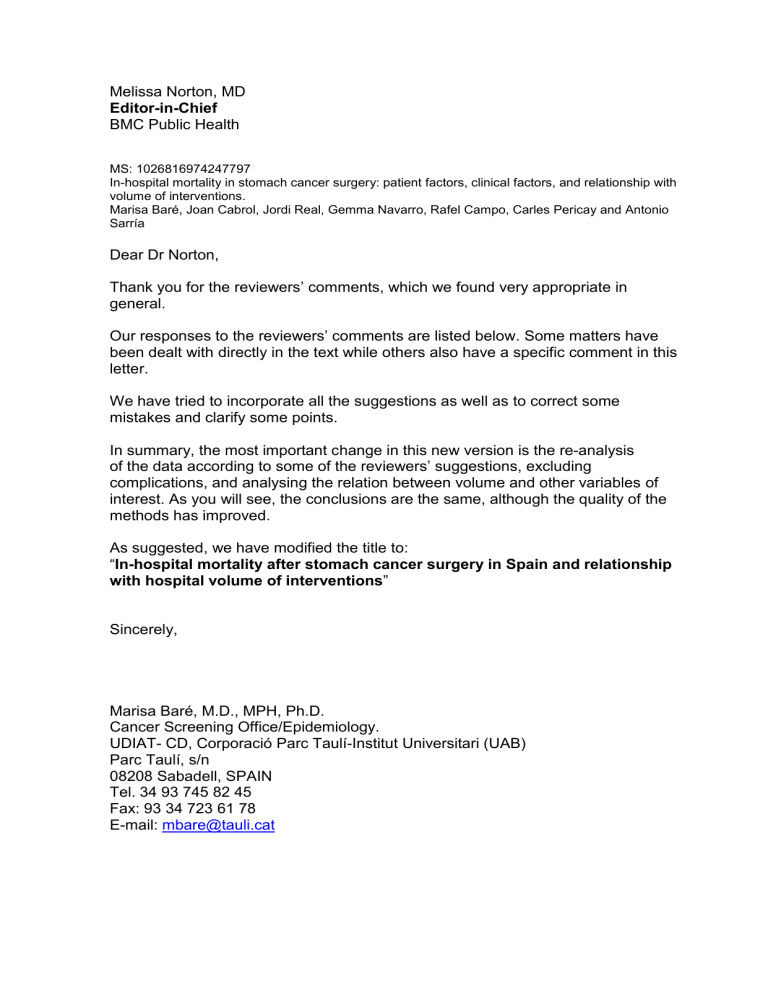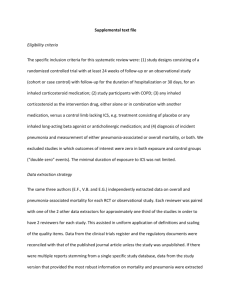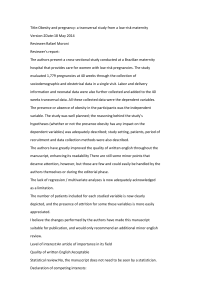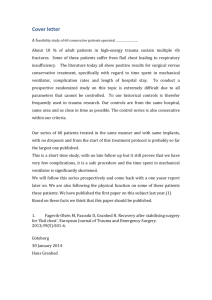Reviewer: Ronald Damhuis

Melissa Norton, MD
Editor-in-Chief
BMC Public Health
MS: 1026816974247797
In-hospital mortality in stomach cancer surgery: patient factors, clinical factors, and relationship with volume of interventions.
Marisa Baré, Joan Cabrol, Jordi Real, Gemma Navarro, Rafel Campo, Carles Pericay and Antonio
Sarría
Dear Dr Norton,
Thank you for the reviewers ’ comments, which we found very appropriate in general.
Our responses to the reviewers’ comments are listed below. Some matters have been dealt with directly in the text while others also have a specific comment in this letter.
We have tried to incorporate all the suggestions as well as to correct some mistakes and clarify some points.
In summary, the most important change in this new version is the re-analysis of the data according to some of the rev iewers’ suggestions, excluding complications, and analysing the relation between volume and other variables of interest. As you will see, the conclusions are the same, although the quality of the methods has improved.
As suggested, we have modified the title to:
“ In-hospital mortality after stomach cancer surgery in Spain and relationship with hospital volume of interventions ”
Sincerely,
Marisa Baré, M.D., MPH, Ph.D.
Cancer Screening Office/Epidemiology.
UDIAT- CD, Corporació Parc Taulí-Institut Universitari (UAB)
Parc Taulí, s/n
08208 Sabadell, SPAIN
Tel. 34 93 745 82 45
Fax: 93 34 723 61 78
E-mail: mbare@tauli.cat
1. Reviewer: Ronald Damhuis
- Authors report for 2001-2002 (with only 2001 data for Andalusia). For hospital volume, it would be better to use annual volume, and to use cut-off values that are used internationally (5, 10, 20, 50). Readers can then compare results more easily.
In agreement with the reviewer’s suggestion, we use the annual volume in the revised manuscript. As the reviewer suggests, it seems logical to use homogeneous cut-off points to enable comparisons between studies. However, the literature on gastric cancer consulted uses different cut-off points and there is no apparent consensus. This is evident in Table 5 (Table 3 in the previous version of the manuscript). Thus, we think it is best for us to use a criterion based on our case distribution, just as other authors have done.
- Some information on the hospital system in Spain is required. With 3241/121, approximately 27 cases in 2 years per hospital, gastric cancer seems a rather common disease in Spain. Do all hospitals perform gastric surgery?
The regions analyzed comprise 52% of the total population of Spain and were selected in part because they are the areas with the greatest technological development where most interventions of this type are carried out. Two of these regions also receive referrals from other areas, so they carry out many more interventions per year, as is shown in Table 1. Therefore, the mean number of cases cannot be extrapolated to the rest of Spain. On the other hand, we point out that there was an error in reporting the number of centers participating in the study: there were 144 altogether.
- I do not understand how the Charlson Index was calculated. As far as I know, this pertains to comorbidity present before diagnosis. It appears as if the authors also included complications occurring after surgery. Table 1 suggests a very high proportion of patients with Charlson Score >=3, much more than in other surgical series.
Only the secondary diagnoses considered in the Deyo adaptation were considered in the calculation of the Charlson Index. Thus, complications occurring after surgery were not included. Without doubt, the distribution of the Charlson scores is related with the thoroughness in registering secondary diagnoses. In our series, many patients had as many as 13 secondary diagnoses, and this may have had a significant impact on the distribution of the scores. We have not compared our distribution with those of other published series, but we think this is an interesting question for future analyses.
- In many countries, cardia cancer is treated by esophagectomy. This does not seem to be the case in Spain. Please elaborate on this phenomenon.
Indeed, esophagectomy is not considered a common practice in Spain. It was not selected by the group of experts who listed the most frequent interventions for gastric cancer (annex). Moreover, as we analyzed only those patients with gastric cancer who had undergone at least one of the procedures described in the annex, if
some patients did undergo esophagectomy, they would not be included in our analysis.
- A 30% urgent admission type is very high for gastric cancer, in comparison to other series. Is this true or related to the definition of urgency?
This percentage refers to patients who were admitted without prior scheduling; in other words, these patients were admitted through the emergency department in critical condition and underwent the intervention before being discharged from the hospital. Other authors, including for example Gordon et al. report 40% gastrectomies admitted through the emergency department; Smith DL et al. have a somewhat lower rate than ours, but Backman et al. report 59% emergency admissions in patients undergoing surgery for gastric cancer. Thus, we consider that 30%, although certainly higher than we would desire in all respects, is in line with some of the values reported in the literature we reviewed.
- In table 2 I do not understand whether the authors refer to complications or to secondary diagnoses. If these are complications, the actual complication risk is rather small but the fatality rate is high. Explanation ‘d’ on page 9 suggests that you cannot distinguish pre- and post-op health problems, which makes the results non-interpretable.
As the reviewer astutely points out, it is not possible to distinguish between preoperative and postoperative problems due to the way the information was coded in the source. Therefore, Table 2 includes certain diagnoses that the experts considered to be important factors in postoperative hospital mortality regardless of whether they occurred before or after the intervention. Some of them occur at very low frequencies, but, as the reviewer observes, it is true that they lead to high mortality (see, for example, respiratory failure or kidney failure or peritonitis or acute myocardial infarction). Nevertheless, we analyzed the data excluding complications using the initial classification elaborated by the experts for the study. Thus, the adjusted analysis only includes the Charlson index and the secondary diagnoses that were associated to mortality in Table 2, which are not considered complications.
- It is unclear how valid the surgery coding is. Especially the information on lymph node resection looks strange. I assume that in Spain D1 surgery is standard which means that some lymph nodes will be present in the surgical specimen.
Unfortunately, as we mention in the discussion, the ICD-9-CM coding system does not consider the specific aspects of surgery for gastric cancer or other oncological ones in which it would be interesting to know the exact type of node excision (D1 or
D2), and the codes referred to in the manuscript are only those available in the hospital discharge database, which also probably suffer from undercoding.
2. Reviewer: Salvador
Peiró
2-...These biases are evident in this study in that chronic morbidity (Charlson =3) appears to be a protection factor compared to Charlson 2, and it would be important to know whether these factors differed between the different types of hospitals. We believe this study needs to provide information about the number of diagnostic notes included (number of secondary diagnoses) and their distribution in terms of the volume of surgery for stomach cancer in each hospital.
Unfortunately, as the reviewer well knows, the number of codes varies in function of the region considered. Thus, while some centers code only three secondary diagnoses, others include up to 13. For this reason, in agreement with the reviewer’s suggestion, we thought it appropriate to create a variable that takes into account this possible bias, compare it according to the volume of interventions in the different centers, and also include it as a covariable in the multivariate analysis.
Thus, it seems clear that the higher the number of secondary diagnoses, the higher the mortality, although the most strictly correct interpretation would be that more secondary diagnoses were registered in the patients who died than in those who survived; this circumstance should be taken into account in relation to possible bias in studies that use hospital discharge databases.
3.-....It, therefore, seems approriate to provide information about the LOS in each hospital and relate this data to the hospital’s volume of cancer stomach surgery.
4. It would be useful to see a table comparing surgery volume and certain patient characteristics. Table 1 could be replaced by a table with more information about the distribution of risks and the quality of information about the three hospital groups.
We now report this information in the corresponding section and in Table 3.
5. Additionally, the use of the Cox proportional hazards models rather than regression logistics or the chi-squared analysis would contribute to palliating the differences in length of stay. While the Cox models cannot control for all the problems associated with the bias described above, they are a better alternative to ignoring the time each patient is remains in hospital. But it should be borne in mind that the length of stay is ambivalent in relation to the quality of the care received (greater LOS may be the result of complications, but also may be the cause of complications such as nosocomial infections). Obviously, it would be much better to have information about mortality at 30 or 60 days, but this outcome is not available through the MBDS. There are also other ways to manage this LOS bias (see Miyata H et al. Performance of in-hospital mortality prediction models for acute hospitalization: Hospital Standardized Mortality Ratio in
Japan. BMC Health Serv Res. 2008; 8:229).
We consider that adjusting for length of stay might not improve the explicative power of the model very much, just as Miyata H et. argue in their study. Our objective was to identify risk factors for or predictors of greater hospital mortality. As the reviewer correctly notes, a longer stay does not necessarily imply greater or lesser mortality and a longer stay can, in turn, lead to complications (e.g.,
infections) that might be the true cause of death. In any case, it does seem that the length of stay is longer in centers that perform more than 17 interventions per year and the volume of int erventions is also related with the patients’ severity. For these reasons, we consider that it is not necessary to control for the possible bias that would be attributable to length of stay. Furthermore, as LOS is closely related to the outcome studied (mortality), it might mask the effect of other factors of interest.
6. For the selection of the cases included in the study, the authors appear to have used the ICD9CM codes for all 151 diagnoses (which excludes in situ stomach carcinoma, code 230.2), and the codes for procedures 43.0 to 43.9 that they define as “total o partial gastrectomy”, but that include procedures that are exploratory (43.0 Gastrotomy) as well as palliative (43.11 and 43.19 gastrostomy, a procedure performed basically for nutritional support). .....The authors should either justify or case selection methods. They should, further, clearly describe the volume of patients receiving these procedures in each type of hospital, since less specialized hospitals may perform procedures differently than those with high volumes of stomach cancer surgery.
We are sorry for erroneously writing codes 43.0-43.9 in the methods section; in fact, we analyzed codes 43.5-43.9. Thus, this is a typographical error rather than a conceptual one (see the annex in the original manuscript). As is clear in the annex, we only took into account the codes related to surgery with the intent to cure.
7. 8. Y 9. The inclusion of complications as a risk adjustment factor is inappropriate when making comparisons between types of hospitals, since complications may be associated with low quality of hospital care and to be, in fact, the cause of death. ...
Clinical judgement should, therefore, be used to discard from the adjustment those complications that were probably not present upon admission. .... The authors should apply clinical judgement to include only secondary diagnoses present upon admission, and exclude any appearing after surgery.
The source we used, the hospitals
’ discharges database, makes it impossible to distinguish between preoperative and postoperative problems. Therefore, Table 2 includes certain diagnoses that the experts considered might be important factors for hospital mortality, regardless of whether they appeared before or after the operation. Nevertheless, we have analyzed the data again from the initial classification elaborated by the experts consulted for the study and excluding the complications . Thus, the adjusted analysis only considers the Charlson index and those secondary diagnoses in Table 2 that were not classified as complications and that fulfilled the criteria described in the methods section.
13. Page 5. Paragraph 2.4.- Inhospital mortality is defined as “death occurring during the hospital stay”. However, the MBDS includes a code for “in extremis discharge” (patients discharged alive to die in their homes), and these cases should also be considered as in-hospital deaths. The authors should explain whether they have done this.
We considered only the deaths that actually occurred in the hospital. In any case, we estimate that this possibility is very unlikely in patients undergoing surgery with the intention to cure.
14. Page 4. Paragraph 2.4.- The cut-off by terciles to classify the hospitals seems to have been done in function of the patients rather than of the hospitals. This cut-off point is not very clear, since it is difficult to envisage the volume of surgery that should be considered "low", "medium" or "high". Additionally, the authors do not say how many hospitals are included in each group. The authors also need to explain better the “13 volume categories corresponding to smaller ranges consisting of 10 discharges each”, as this is description is confuse.
As the reviewer suggests, it seems logical to use homogeneous cut-off points for low and high volumes in different studies. However, the most recent references consulted about gastric cancer all use different cut-off points and there is no apparent consensus (see Table 5 in the revised manuscript —Table 3 in the original manuscript). Thus, we thought it correct to use a criterion based on the distribution of our cases, just as other authors have done.
3. Reviewer: Barbara Peleteiro
- Why use this definition and cut-points of hospital volume? Do other articles use the same definition and cut-points? This information should be presented in table
3 and further discussed; in addition, it should be stated how the authors identified the articles presented in table 3 (was it by a systematic review?).
Table 5 in the revised manuscript (Table 3 in the original manuscript) includes the different cut-off points used in other studies. The studies were identified by searching for gastric or stomach cancer and volume in PubMed and by reviewing the references of the articles. It was not a systematic review, since we did not look for unpublished studies or assess the quality of the studies.
- The authors asked to experts to pre-select factors that might be associated with inhospital mortality; however, it wasn’t possible to include the stage of the tumor due to the inexistence of this information in the database used; this should be further discussed in the discussion section; what the authors would expect to change in the results if this data had been available in accordance to other studies.
We deal with this subject in the discussion of the revised manuscript.







